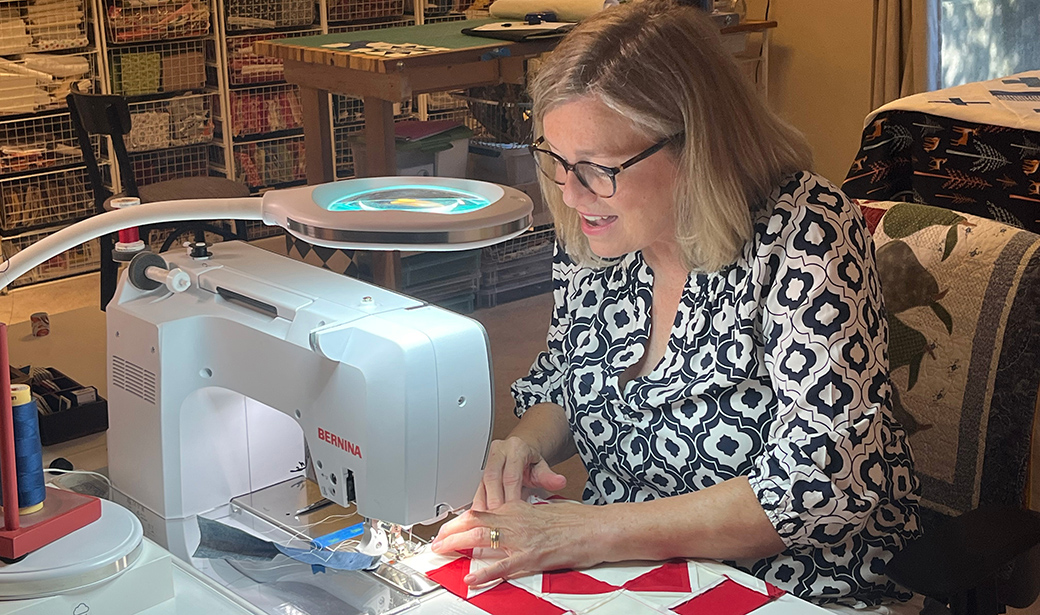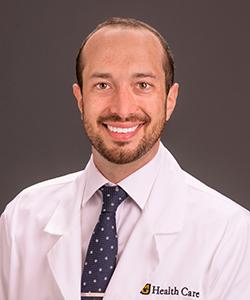Mette Brown started making quilts in 1997, and before long, her hobby evolved into what she now calls a “ridiculous obsession.” The basement of her Columbia home is devoted to quilting, with her current work-in-progress hanging on the wall behind her sewing station and old favorites accessorizing every available piece of furniture.
“If I could do it all day long, every day, I would,” she said.
As much as she loves quilting, Brown had to give it up in the fall of 2021. That’s when the cortisone shots she had been getting to manage the pain in her left thumb stopped working. The pain made it impossible to keep snipping and stitching, and it affected other parts of her life too. She had to give up babysitting her youngest grandchild because she couldn’t pick him up or hold him, and the throbbing thumb interrupted her sleep at night.
“The pain starts just when you’re using the hand, but it eventually becomes all the time,” Brown said.
Arthritis at the base of the thumb is a common and unpreventable problem for people over 50 — especially women. When the cartilage that cushions the basal joint wears down, the bones start rubbing together, causing pain that makes it hard to perform tasks that require gripping and twisting.
Daniel London, MD, a hand and wrist surgeon at MU Health Care’s Missouri Orthopaedic Institute, said people with thumb arthritis can sometimes manage the condition with braces, anti-inflammatory skin creams or cortisone injections. But for people like Brown, whose pain persists and affects daily life, surgery can provide a lasting solution.
Brown was reluctant at first when London mentioned surgery. In 2012, while living in Alabama, she had surgery for arthritis in her right thumb, and the recovery was long and painful. She couldn’t quilt again for nearly a year. London assured her that recovery after the new version of the surgery he performs would not require a cast and that she could return to her favorite activities in 90 days, if not sooner.
“I remember thinking, ‘He’s crazy. No matter how hard I work, I won’t be able to do that,’” she said.
Eventually, her pain outweighed her worries about the length of recovery. London performed the procedure in April 2022.
He began by removing the trapezium, a small bone less than an inch long that connects the thumb to the wrist. He then took a small strip of tendon and anchored the base of her first metacarpal (which leads to the thumb) to the base of the second metacarpal (which leads to the index finger). Finally, he attached two thick sutures, which resemble dental floss, to the same bones. The sutures and tendon form a hammock under her thumb that prevents it from rubbing on any other bones or slipping back into the space where the trapezium once was.
“What’s different about this procedure is the two suture pieces we use besides the tendon,” London said. “The tendon needs to heal and be stable in place, so if you had a tendon procedure, you’d be casted for six or eight weeks until everything healed. The sutures are stable immediately once we leave the operating room, so that lets me have my patients go to therapy to get a special smaller brace, usually four to five days after surgery, and they start working on range-of-motion exercises at that same visit.”
With the help of Mizzou Therapy Services’ hand therapists, Brown reached full range of motion — touching her thumb to the pad of her pinky finger — in just 75 days. At that point, she was free to resume quilting. In fact, all the cutting, sewing and ironing helped her continue to build strength in her hand.
“After surgery, getting back to activities that promote motion are fantastic,” London said. “Doing what you enjoy doing becomes your therapy at home.”
For Brown, a perfect day includes a house full of family, football games on TV and a new quilt coming together in her hands. She will have plenty more perfect days in her future.
“When you can’t comfortably do what you want to do and what you’re used to doing, it’s time to go to the doctor,” Brown said. “I shouldn’t have put it off. I’m happily amazed that I no longer have pain.”




